

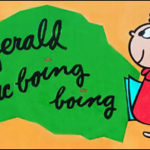
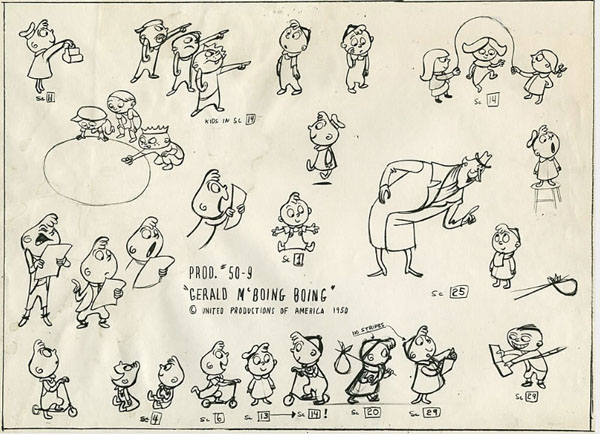
“This is the story of Gerald McCloy and the strange thing that happened to that little boy.” So begins the whimsical, funny, touching tale of Gerald McBoing-Boing, the classic cartoon short from United Productions of America (UPA), celebrating its 75th anniversary this fall.
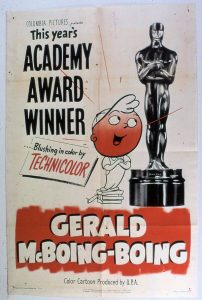 Directed by Robert Cannon, with John Hubley as supervising director, and narrated by Marvin Miller, it tells the story of the title character, a young boy who, at the age he is supposed to start talking, instead just makes the sound “Boing! Boing!”
Directed by Robert Cannon, with John Hubley as supervising director, and narrated by Marvin Miller, it tells the story of the title character, a young boy who, at the age he is supposed to start talking, instead just makes the sound “Boing! Boing!”
His parents, in a panic, call a doctor, but he is as shocked as the parents and announces that he has no cure. Months pass and not only does Gerald keep going “Boing! Boing!,” but he begins to make other sound effects, like an explosion that scares his father out of his chair and sends him clinging to the chandelier.
The parents think that the cure is to send Gerald to school, but that doesn’t work, and Gerald is sent home almost immediately with a note pinned to his jacket, stating that there’s nothing that the teacher or school can do for Gerald.
The other kids in the neighborhood tease poor Gerald, “Your name’s not McCloy, your Gerald McBoing-Boing, the noisemaking boy.” So sad and desperate, Gerald runs away from home and is discovered by a man who recognizes Gerald’s unique ability and offers the young boy a job at his radio station.
With that, Gerald finds success creating the sound effects for a Western radio drama, becoming quite the celebrity as the short ends on a happy note.
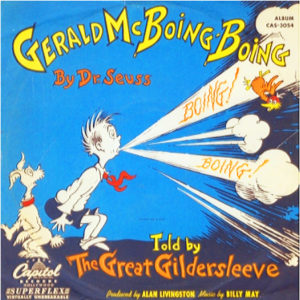 Gerald McBoing-Boing started life as a children’s record album written by Theodore Geisel, known to the world as Dr. Seuss, and read, in the author’s comforting rhyme, by actor Harold Peary, credited on the album cover as “The Great Gildersleeve,” a very popular character on radio that Peary played at the time.
Gerald McBoing-Boing started life as a children’s record album written by Theodore Geisel, known to the world as Dr. Seuss, and read, in the author’s comforting rhyme, by actor Harold Peary, credited on the album cover as “The Great Gildersleeve,” a very popular character on radio that Peary played at the time.
The story came to UPA (who had recently found success with their new character, Mr. Magoo) when Geisel had lunch one day with Phil Eastman a writer and storyboard artist at the studio – who had worked with Geisel during World War 2. From their conversation, Geisel brought the record to the UPA Studio to discuss the possibility of adapting it for animation.
Producer Steve Bosustow, one of the founders of UPA, listened to the album and quickly purchased the rights.
The subsequent short Gerald McBoing-Boing proved to be a landmark for both the UPA Studio and the animation industry. UPA had been founded by former Disney Studio artists who sought to create animation that was innovative in terms of story and style.
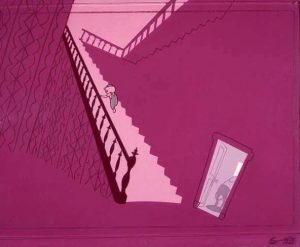 Gerald McBoing-Boing most definitely accomplished this, eschewing the realism found in films from studios like Disney and instead using a bold, graphic look in this and their other short subjects that went on to inspire animation at other studios, and became indicative of this era of animation.
Gerald McBoing-Boing most definitely accomplished this, eschewing the realism found in films from studios like Disney and instead using a bold, graphic look in this and their other short subjects that went on to inspire animation at other studios, and became indicative of this era of animation.
In his book When Magoo Flew: The Rise and Fall of Animation Studio UPA, author Adam Abraham wrote that with Gerald McBoing-Boing, “… everything coalesced – all the ideas and experiments on which UPA’s artists had been working for five years or more. Walls in the backgrounds disappear; spaces are defined by a random piece of furniture or two; chandeliers dangle in midair. The character designs are flat, two-dimensional – unequivocally, they are drawings, not meant to be mistaken for anything else. The animation is precise and balletic, and the colors shift from scene to scene, expressionistically.”
The distinctive style of Gerald McBoing-Boing, thanks to design by Bill Hurtz, and color by Herb Klynn and Jules Engel, highlights all that the story (adapted by Bill Scott and Eastman) holds. The animation of the stylized characters, from a team that included Bill Melendez, Rudy Larriva, Pat Matthews, Willis Pyle, and Frank Smith, brings the humor, heart, and emotion in the short to life. A scene in which Gerald, in despair, can’t turn to anyone, including his parents, plays out as Gerald ascends the staircase, which seems to float in space, underlying the loneliness of the moment and packing quite a punch.
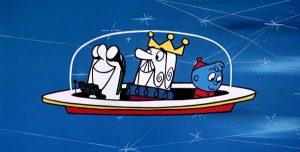
From “Gerald McBoing Boing on The Planet Moo” (1956) directed by Bobe Cannon
Sixty-five years later, the original, artistic vision, coupled with a universal theme of how we all have our unique gifts, has helped Gerald McBoing-Boing secure its place in animation history. In 1994, the short was placed at number nine in Jerry Beck’s book, The 50 Greatest Cartoons.
In it, there’s a quote from a 1952 interview John Hubley conducted with The New York Times, where he summed up Gerald McBoing-Boing perfectly, saying, “It started a revolution in animation. We proved with Gerald that a short can cut across the whole of the audience and can be made attractive and entertaining to both adults and youngsters.”